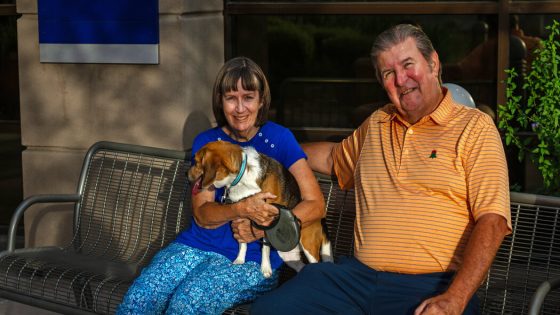The Food and Drug Administration on Tuesday approved a new drug for Alzheimer’s disease, the latest in a novel class of treatments that has been greeted with hope, disappointment and skepticism.
The drug, donanemab, to be sold under the brand name Kisunla, was shown in studies to modestly slow the pace of cognitive decline in early stages of the disease. It also had significant safety risks, including swelling and bleeding in the brain.
Kisunla, made by Eli Lilly, is similar to another drug, Leqembi, approved last year. Both are intravenous infusions that attack a protein involved in Alzheimer’s, and both can slow the unfolding of dementia by several months. Both also carry similar safety risks. Leqembi, made by Eisai and Biogen, is given every two weeks; Kisunla is given monthly.
Kisunla has a significant difference that may appeal to patients, doctors and insurers: Lilly says patients can stop the drug after it clears the protein, amyloid, which clumps into plaques in the brains of people with Alzheimer’s.
“Once you’ve removed the target that you’re going after, you then can stop dosing,” said Anne White, an executive vice president of Lilly and president of its neuroscience division. She said that this could reduce the overall cost and inconvenience of the treatment as well as the risk of side effects.
The company said that 17 percent of patients receiving donanemab in the 18-month-long clinical trial were able to discontinue the drug at six months, 47 percent stopped within a year and 69 percent stopped within 18 months. Their cognitive decline continued to slow even after they stopped. The company is evaluating how long that slowing will continue past the duration of the trial, said Dr. John Sims, a medical director at Lilly.
The list price for Kisunla will be $32,000 for a course of therapy lasting a year. Leqembi costs $26,000 per year, but is not stopped after amyloid is cleared. The higher price, Ms. White said, reflects the expectation that the patients can stop Kisunla after their plaques are cleared.
Kisunla and Leqembi are considered only an incremental step in the search for effective Alzheimer’s treatments. Some experts say they may not slow decline enough to be noticeable to patients or families.
The medications belong to a new class of drugs that address the underlying biology of Alzheimer’s by attacking amyloid, which begins to accumulate in the brain years before symptoms appear. The first drug in that class to receive approval was Aduhelm in 2021, but its maker, Biogen, discontinued it last year because there was insufficient evidence that it could benefit patients. So far, there are no treatments that stop or reverse memory loss or other cognitive problems.
Some Alzheimer’s experts are skeptical of the anti-amyloid drugs and said they believed the risks outweighed the potential for a slight benefit.
Dr. Michael Greicius, a neurologist at Stanford University School of Medicine, said he had not prescribed Leqembi and would also not offer Kisunla. He said that if the drugs were effective, the data should show that individual patients who had more amyloid removed from their brains experienced slower rates of cognitive decline, just as medications for H.I.V. have shown that the more a drug reduces a patient’s viral load, the better that patient’s health and likelihood of survival.
But so far, Dr. Greicius said, “There’s no correlation in any of their studies between the removal of amyloid plaques and the clinical response in individual subjects.” That, he added, raised the question of “how is this drug working, if at all, and it’s kind of frustrating and agonizing for me as a clinician.”
Other experts said they considered it valuable to offer patients the drugs even though the benefit might be modest.
Dr. B. Joy Snider, a professor of neurology at Washington University School of Medicine who has been involved in trials of the drugs and previously served as a consultant to both Eisai and Lilly, said the slowing of decline was “not a huge difference,” but could be meaningful in people’s lives — for example, by delaying progression from mild forgetfulness to having to be reminded about appointments.
“At least at the group level, clearing of amyloid correlates with slowing of disease progression,” she said. “It’s going to be hard to see these correlations in an individual patient,” she said, because memory and thinking problems can fluctuate and because during testing “you don’t know if you’re getting a good day or bad day.”
In a trial of 1,736 early-stage patients — people with either mild cognitive impairment or mild dementia — cognitive decline slowed by about 4½ to 7½ months over 18 months in those receiving donanemab compared with those who got the placebo. On an 18-point cognitive scale, the overall group of patients receiving the drug declined 29 percent more slowly than the placebo group, for a difference of seven-tenths of a point.
Nearly half of those who received donanemab stayed at the same cognitive level one year into the study, compared with 29 percent who got the placebo.
About one-fourth of those on donanemab experienced swelling or bleeding in the brain. While most of the cases were mild or asymptomatic, about two percent were serious, and the side effects were linked to the deaths of three patients.
The donanemab trial had higher rates of swelling and bleeding than the Leqembi trial, but comparisons are difficult because of differences in patients and other factors.
With both drugs, patients at higher risk include those who have had more than four microscopic bleeds in the brain and those with an Alzheimer’s-linked gene variant called APOE4 — especially if they have two copies of the variant.
Bev Krol, 69, of Phoenix has been a donanemab study participant for nearly three years, receiving infusions at Banner Alzheimer’s Institute, one trial site. Neither she nor doctors know when she received donanemab and when she received a placebo. (If she received a placebo during the initial 18-month phase, she would have started on the drug in the extension phase. If she received the drug during the initial 18-month phase, odds are that her amyloid would have cleared and she would receive a placebo at some point during the extension phase.)
In an interview arranged by Lilly, her husband, Mark Krol, said that during the initial 18 months, doctors said periodic scans sometimes found microbleeds in Ms. Krol’s brain, but none serious enough to stop the infusions.
Mr. Krol said that about six years ago, his wife, who had worked in sales and marketing for Coca-Cola and had been highly organized with a keen memory, became increasingly forgetful. Instead of baking multiple loaves of her signature cranberry-orange nut bread simultaneously, baking even one became “a struggle,” he said. She would say, “‘I’m not sure if I put the ingredients in correctly,’” he said.
She was diagnosed with mild cognitive impairment, a predementia stage. “From then ’til now, it went from asking me the same question twice in one day to asking the same question twice in 10 seconds,” Mr. Krol said.
Ms. Krol said she didn’t feel that she was experiencing cognitive decline. She said her main activity now was walking their beagle, Bailey, twice a day, and that the reason she no longer regularly golfed with friends was “not that I can’t do it, I just am so tired of doing stuff.”
Mr. Krol said her decline in memory and attention had continued gradually, but he hoped it had been slowed by the drug.
“It is not a silver bullet,” he said. But, he added, “I do think it’s significant, and I do think it warrants F.D.A. approval.”
Dr. Snider said some patients decided against starting anti-amyloid drugs “as soon as they heard anything about brain swelling or edema being a risk at all.” Others are so “terrified of losing their memory,” she said, that “they don’t really care how much risk you tell them they have.”
One unusual feature of the donanemab trial involved measuring levels of another protein, tau, which forms tangles in the brain after amyloid accumulates and is more closely associated with memory and thinking problems.
Trial participants with intermediate tau levels declined more slowly on donanemab than those with high levels, suggesting that treating patients earlier was more effective. That raised a question of whether patients should have tau brain scans before starting the drug, but neither Lilly nor the F.D.A. recommended that because scans for tau are not widely available.
Experts said there were several unknowns about discontinuing treatment after plaques were cleared. At some point, “Do we need to restart them?” Dr. Snider wondered. “Do we need to replace it with something else?”
Lilly scientists don’t have those answers yet. Dr. Sims estimated it would take nearly four years for amyloid levels to bump back up over the threshold and potentially a decade to reach the amount patients had before starting treatment.
Some experts worry that emphasis on anti-amyloid drugs might discourage patients from participating in trials for treatments that could be better. “For the field generally, I think this is moving sideways, and it’s slowing progress,” Dr. Greicius said.
Dozens of other drugs are in clinical trials for Alzheimer’s, including drugs attacking important features like tau tangles and neuroinflammation.
“Hopefully, this is just the beginning,” Dr. Snider said.
Source Agencies




